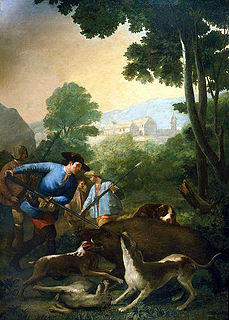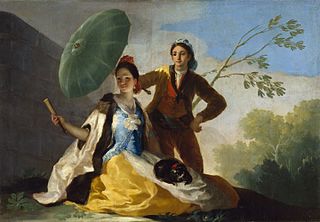 W
WBlind Man's Bluff is one of the Rococo oil-on-linen cartoons produced by the Spanish artist Francisco de Goya for tapestries for the Royal Palace of El Pardo. The work shows boys and girls playing the popular pastime "blind man's buff" with one figure in the middle blindfolded and holding a large spoon while trying to entice others dancing around him in a circle.
 W
WThe Boar Hunt is a painting of 1775 by Francisco Goya and the earliest surviving tapestry cartoon by the artist. It depicts men with dogs and boar spears killing a boar.
 W
WBoys playing soldiers is a 1778-79 tapestry cartoon by Francisco of Goya conceived for the bedroom of the Princes of Asturias in the Royal Palace of El Pardo. It is presently exhibited in the Museo del Prado. A sketch of the artwork is kept nowadays in the Yanduri Collection of Seville.
 W
WChildren in a Chariot is a 1779 painting by Francisco de Goya. It is part of the third series of cartoons he produced for tapestries at the Royal Palace of El Pardo; the tapestry in question was to be positioned over a door. The painting is in the Toledo Museum of Art.
 W
WThis is a complete list of Francisco Goya's 63 large tapestry cartoons painted on commission for Charles III of Spain and later Charles IV of Spain between 1775 and 1791 to hang in the San Lorenzo de El Escorial and El Pardo palaces. The word "cartoon" is derived from the Italian cartone, which describes a large sheet of paper used in preparation for a later painting or tapestry. Goya's were executed on canvas which was then woven into wool tapestry to a large mural scale. While many of the large finished works are today in the Prado Museum, the original sketches were sold as works in their own right.
 W
WThe Parasol is one of a cartoon series of oil on linen paintings made by the painter Francisco Goya. This series of paintings was specifically made in order to be transformed into tapestries that would be hung on the walls of the Royal Palace of El Pardo in Madrid, Spain. The tapestries showed serene events in everyday life, which made them a nice addition to the dining room of Prince and Princess of Asturias—the future King Charles IV and Maria Luisa of Parma. The queen called on Goya because she wanted to decorate the dining room with cheerful scenes; The Parasol and the other tapestry paintings were Goya's response to this request. The painting is currently located in the Museo del Prado in Madrid as is another in the series, Blind man's bluff.
 W
WThe Raphael Cartoons are seven large cartoons for tapestries, belonging to the British Royal Collection but since 1865 on loan to the Victoria and Albert Museum in London, designed by the High Renaissance painter Raphael in 1515–16 and showing scenes from the Gospels and Acts of the Apostles. They are the only surviving members of a set of ten cartoons commissioned by Pope Leo X for the Sistine Chapel tapestries for the Sistine Chapel in the Vatican Palace, which are still hung below Michelangelo's famous ceiling. Reproduced in the form of prints, the tapestries rivalled Michelangelo's ceiling as the most famous and influential designs of the Renaissance, and were well known to all artists of the Renaissance and Baroque. Admiration of them reached its highest pitch in the 18th and 19th centuries; they were described as "the Parthenon sculptures of modern art".
 W
WSummer or The Threshing Floor is the largest cartoon painted by Francisco de Goya as a tapestry design for Spain's Royal Tapestry Factory. Painted from 1786 to 1787, it was part of his fifth series, dedicated to traditional themes and intended for the heir to the Spanish throne and his wife. The tapestries were to hang in the couple's dining room at the Pardo Palace.
 W
WThe Threshing Floor is an oil sketch by Francisco Goya. He painted it in the 1780s as a small-scale sketch for a tapestry cartoon entitled Summer, part of a set of designs for tapestries for the Royal Palace of El Pardo, specifically the rooms of the Prince of Asturias and his wife Maria Luisa.